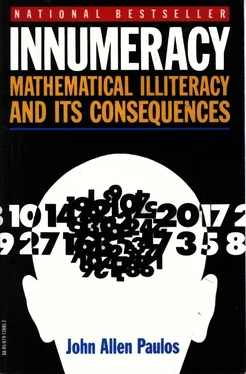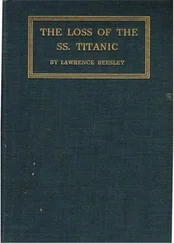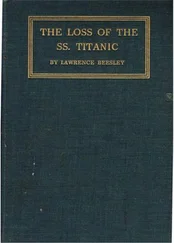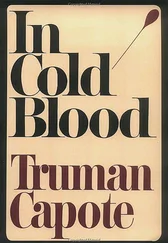Coincidences or extreme values catch the eye, but average or "expected" values are generally more informative. The expected value of a quantity is simply the average of its values weighted according to their probabilities. For example, if 1/ 4of the time a quantity equals 2, 1/ 3of the time it equals 6, another 1/ 3of the time it equals 15, and the remaining 1/ 12of the time it equals 54, then its expected value equals 12. This is so since [12 = (2 x 1/ 4) + (6 x 1/ 3) + (15 x 1/ 3) + (54 x 1/ 12)].
As a simple illustration, consider a home-insurance company. Assume it has good reason to believe that, on average, each year one out of every 10,000 of its policies will result in a claim of $200,000; one out of 1,000 policies will result in a claim of $50,000; one out of 50 will result in a claim of $2,000; and the remainder will result in a claim of $0. The insurance company would like to know what its average payout is per policy written. The answer is the expected value, which in this case is ($200,000 x 1/10,000) + ($50,000 x 1/1,000) + ($2,000 x 1/50) + ($0 x 9,789/10,000) = $20 + $50 + $40 = $110.
The expected payout on a slot machine is determined in like manner. Each payout is multiplied by the probability of its occurring, and these products are then summed up to give the average or expected payout. For example, if cherries on all three dials result in a payout of $80 and the probability of this is ( 1/ 20) 3(assume there are twenty entries on each dial, only one of which is a cherry), we multiply $80 by ( 1/ 20) 3and then add to this product the products of the other payouts (a loss being considered a negative payout) and their probabilities.
An illustration which isn't quite so vanilla: Assume a medical clinic tests blood for a certain disease from which approximately one person in a hundred suffers. People come to the clinic in groups of fifty, and the director wonders whether, instead of testing them individually, he should pool the fifty samples and test them all together. If the pooled sample is negative, he could pronounce the whole group healthy, and if not, he could then test each person individually. What is the expected number of tests the director will have to perform if he pools the blood samples?
The director will have to perform either one test (if the pooled sample is negative) or fifty-one tests (if it's positive). The probability that any one person is healthy is 99/ 100 , and so the probability that all fifty people are healthy is ( 99/ 100) 50. Thus, the probability that he'll have to perform just one test is ( 99/ 100) 50. On the other hand, the probability that at least one person suffers from the disease is the complementary probability [1 – ( 99/ 100) 50], and so the probability of having to perform fifty-one tests is [1 – ( 99/ 100) 50]. Thus, the expected number of tests necessary is (1 test x ( 99/ 100) 50) + (51 tests x [1 – ( 99/ 100) 50]) – approximately 21 tests.
If there are large numbers of people having the blood test, the medical director would be wise to take part of each sample, pool it, and test this pooled sample first. If necessary, he could then test the remainders of each of the fifty samples individually. On average, this would require only twenty-one tests to test fifty people.
An understanding of expected values is helpful in analyzing most casino games, as well as the lesser-known game of chuck-a-luck which is played at carnivals in the Midwest and England.
The spiel that goes with chuck-a-luck can be very persuasive. You pick a number from 1 to 6 and the operator rolls three dice. If the number you pick comes up on all three dice, the operator pays you $3; if it comes up on two of the three dice, he pays you $2; and if it comes up on just one of the three dice, he pays you $1. Only if the number you picked doesn't come up at all do you pay him anything- just $1. With three different dice, you have three chances to win, and furthermore you'll sometimes win more than $1, while that is your maximum loss.
As Joan Rivers might say, "Can we calculate?" (If you'd rather not calculate, skip to the end of this section.) The probability of your winning is clearly the same no matter what number you choose, so, to make the calculation specific, assume you always pick the number 4. Since the dice are independent, your chances that a 4 will come up on all three dice are 1/ 6x 1/ 6x 1/ 6 = 1/ 216so, approximately 1/216th of the time you'll win $3.
Your chances of a 4 coming up only twice are a little harder to calculate unless you use the binomial probability distribution mentioned in Chapter 1, which I'll derive again in this context. A 4 coming up on two of the three dice can happen in three different and mutually exclusive ways: X44, 4X4, or 44X, the X indicating a non-4. The probability of the first is 5/ 6x 1/ 6x 1/ 6= 5/ 216, a result which holds true for the second and third ways as well. Adding, we find that the probability of a 4 coming up on two of the three dice is 15/ 216, which is the fraction of the time you'll win $2.
The probability of obtaining exactly one 4 among the three dice is likewise determined by breaking the event into the three mutually exclusive ways it can happen. The probability of obtaining 4XX is 1/ 6x 5/ 6x 5/ 6= 25/ 216, which is also the probability of obtaining X4X and XX4. Adding, we get 75/ 216for the probability of exactly one 4 coming up on the three dice, and hence for the probability of your winning $1. To find the probability that no 4s come up when we roll three dice, we find how much probability is left over. That is, we subtract ( 1/ 216 + 15/ 216+ 75/ 216) from 1 (or 100%) to get 125/ 216. Thus, on the average, 125 out of 216 times you play chuck-a-luck, you'll lose $1.
The expected value of your winnings is thus ($3 x 1/ 216) + ($2 x 15/ 216) + ($1 x 75/ 216) + (-$1 x 125/ 216) = $(- 17/ 216) = – $.08, and so, on the average, you would lose approximately eight cents every time you played this seemingly attractive game.
There are two approaches to love-through the heart and through the head. Neither one seems to work very well alone, but together… they still don't work too well. Nevertheless, there's probably a better chance of success if both are used. Upon thinking of past loves, someone who approaches romance through the heart is likely to bemoan lost opportunities and conclude that he or she will never again love as deeply. Someone who takes a more hard-headed approach may be interested in the following result in probability.
The model we'll consider assumes that our heroine-call her Myrtle-has reason to believe that she'll meet N potential spouses (spice?) during her "dating life." N could be two for some women, two hundred for others. The question Myrtle poses to herself is: When should I accept Mr. X and forgo the suitors who would come after him, some of whom may possibly be "better" than he? We'll assume she meets men sequentially, can judge the relative suitability for her of those she's met, and once she's rejected someone, he's gone forever.
For illustration, suppose Myrtle has met six men so far and that she rates them as follows: 3 5 1 6 2 4. That is, of the six men she's met, she liked the first one she met third-best, the second one she liked fifth-best, the third one she liked best of all, and so on. If the seventh man she meets she prefers to everyone except her favorite, her updated ranking would become: 4 6 1 7 3 5 2. After each man, she updates her relative ranking of her suitors and wonders what rule she should follow in order to maximize her chances of choosing the best of her projected N suitors.
The derivation of the best policy uses the idea of conditional probability (which we'll introduce in the next chapter) and a little calculus. The policy itself, though, is quite simple to describe. Call a suitor a heartthrob if he's better than all previous candidates. Myrtle should reject approximately the first 37 percent of the N candidates she's likely to meet, and then accept the first suitor after that (if any) who is a heartthrob.
Читать дальше












